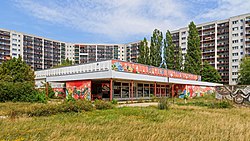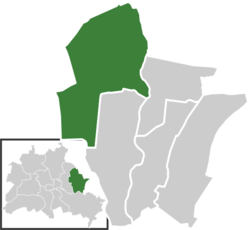Berlin Marzahn
| Marzahn | ||
|---|---|---|
| Quarter of Berlin | ||

Bärensteinstraße: apartment houses and an abandoned retail building
|
||
|
||
| Coordinates: 52°33′00″N 13°33′00″E / 52.55000°N 13.55000°ECoordinates: 52°33′00″N 13°33′00″E / 52.55000°N 13.55000°E | ||
| Country | Germany | |
| State | Berlin | |
| City | Berlin | |
| Borough | Marzahn-Hellersdorf | |
| Founded | 1300 | |
| Area | ||
| • Total | 19.5 km2 (7.5 sq mi) | |
| Elevation | 112 m (367 ft) | |
| Population (2008-06-30) | ||
| • Total | 102,398 | |
| • Density | 5,300/km2 (14,000/sq mi) | |
| Time zone | CET/CEST (UTC+1/+2) | |
| Postal codes | (nr. 1001) 12671, 12679, 12681, 12685, 12687, 12689 | |
| Vehicle registration | B | |
Marzahn is a locality within the borough of Marzahn-Hellersdorf in Berlin. Berlin's 2001 administrative reform led to the former boroughs of Marzahn and Hellersdorf fusing into a single new borough. In the north the Marzahn locality includes the neighbourhoods of Bürknersfelde and Ahrensfelde, an overbuilt strip of land which once had belonged to the Brandenburg municipality of Ahrensfelde and was incorporated into Berlin in 1990.
Marzahn is divided into 3 zones (Ortslagen):
The historic village of Marzahn was first mentioned as Morczane in a 1300 deed by Margrave Albert III of Brandenburg-Salzwedel, when he granted the estates to the Friedland Cistercian abbey (in today's Neuhardenberg). After the Thirty Years' War it fell to Elector Frederick William of Brandenburg. The new village church was finished in 1871 according to plans by Friedrich August Stüler, another landmark is the Marzahn post mill, rebuilt in 1994. The village became part of Greater Berlin in 1920, as a locality of the Lichtenberg district.
Marzahn was the site of a labour camp (today a water treatment plant), where Romani were interned from July 16, 1936 on, two weeks prior to the 1936 Summer Olympics in Berlin, away from visitors' eyes. As a part of the Nazi Porajmos extermination policy, up to 2000 inmates remained there until in 1943 they were deported to Auschwitz-Birkenau, where most of them were gassed. In 1941 the large factory of the Carl Hasse & Wrede machine tool company (now Knorr-Bremse) was erected, where hundreds forced labourers were employed. The victims were buried at the nearby Parkfriedhof, a memorial marks the site. On April 21, 1945 the district of Marzahn was the first in Berlin to be conquered by the Red Army under General Nikolai Berzarin. The "first freed house" stands on Landsberger Allee.
...
Wikipedia



